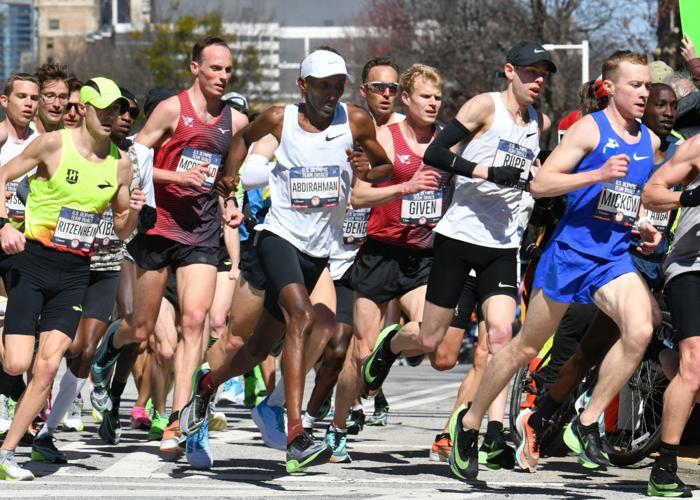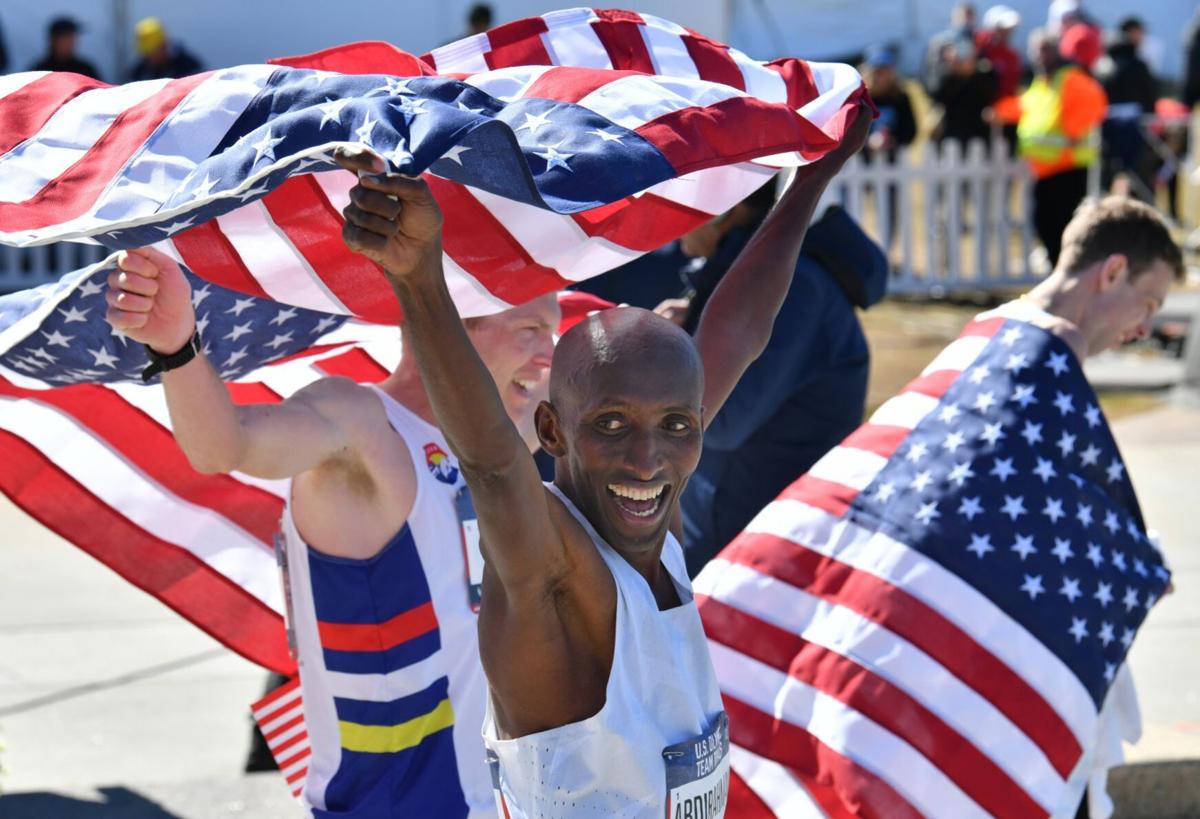Announcers on NBC’s telecast of the U.S. Olympic marathon trials made their first purposeful mention of Abdi Abdirahman 1 hour and 42 minutes into Saturday’s race.
“This is astonishing,” said analyst Craig Masback. “This is legendary.”
Thirty minutes later, wrapped in an American flag, Abdirahman held up five fingers, symbolic of qualifying for his fifth Olympic team since becoming a world-class distance runner at the UA and Pima College.
“This was not a fluke,” Abdirahman said. “I wanted to do something that hadn’t been done before.”
And so he did.
Abdirahman, 43, is believed to be the oldest person ever to make America’s Olympic track and field team. He was paid $55,000 for his work but the legend he established is priceless.
At the time Abdirahman was crossing the finish line in downtown Atlanta, third out of 671 runners, his coach, Tucsonan Dave Murray, was at Arizona Veterans Memorial Coliseum watching Salpointe Catholic win the Class 4A state boys basketball championship.
“My grandkids go to Salpointe,” said Murray, who fully “discovered” Abdirahman on the Pima College track team in 1995 and has coached him ever since. “I was going to watch the race when I got home and thought maybe I could get back to Tucson without knowing how it turned out.”
Good luck with that. The news was too big to hold.
About the time Salpointe was celebrating its championship, Murray’s phone buzzed. It was Dawn Boxley, director of operations for the UA track and field program. Boxley was Abdirahman’s UA teammate and had been one of Murray’s assistant coaches at Arizona.
“Congratulations coach,” said Boxley.
Murray paused. “What did I do?” he replied.
“Abdi just made the Olympic team.”
Murray spoke loudly, trying to be heard over the commotion at the basketball arena. “Abdi won!” he shouted. “Abdi won!”
Abdirahman didn’t really win. Former Oregon runner Galen Rupp finished first, but the top three Americans make the Olympic team in every track and field event. Third? First? Who cares? When the 2020 Olympic marathon championships are held Aug. 9 in Sapporo, Japan, Abdirahman will be in uniform the same way he was in 2000, 2004, 2008 and 2012. He will become the first five-time U.S. Olympic track and field athlete.
On his drive back to Tucson, Murray’s phone buzzed again. This time it was Abdirahman.
“I could tell by the tone of his voice this was extra special,” said Murray. “There were so many good runners in that field. I thought he had a shot — I thought it was a possibility — but let’s put it this way: I learned long ago not to doubt Abdi.”

The lead runners, including Abdi Abdirahman and race winner Galen Rupp, charge through downtown Atlanta during the U.S. Olympic marathon trials.
This didn’t just happen because the marathon gods owed Abdirahman one after what was believed to be his last shot at the Olympics, in 2016, went awry because of hip and leg injuries. It happened because Abdirahman left Tucson before Thanksgiving intent on some of the most intense prep work of his career.
“I moved to Ethiopia for three months,” he said. “You just see me in the race, but it was those three months of hard training that made it possible.”
Training at an altitude of about 10,000 feet with, among others, Tucsonan Bernard Lagat, a five-time Olympic distance runner for both Kenya and America, put Abdirahman in the best shape of his life — or close to it.
“We’d talk about his training schedule and how his body was holding up,” Murray said. “He was training with other elite runners like (Lagat), very enthusiastic and confident. He flew back to Tucson for about three days and then got in two more weeks of altitude training in Flagstaff before going to Atlanta. He had such positive vibes.”
After initial jostling in the pack of runners Saturday, Abdirahman never fell out of the lead group. NBC cameras briefly focused on him 30 minutes into the race. He was 10th. Fifteen minutes later he was fifth. The race was on.
“He ran within a minute and a half of his lifetime best in the marathon,” Murray said with a tone of admiration. “His best (2:08.08) was many years ago (2007) when he was a much younger man.”
Abdirahman was a 10,000-meter runner at Sydney in 2000, Athens in 2004 and Beijing in 2008. He was never worse than 15th in those Olympic competitions. But upon returning from China in 2008, Abdirahman, then 31, discussed a move to the marathon.
“I told (Murray) I was never going to run the marathon,” Abdirahman told me. “It took a year or two to convince me that would be a good move.”
Murray and Abdirahman began their Olympic partnership 20 years ago on a hot summer night in Sacramento. In the 10,000-meter finals, Abdirahman struggled to keep up with the leaders. Something was wrong. Abdirahman was wearing the wrong shoes.
His sponsor, Nike, had given him new running shoes the day of the Olympic Trials finals. Rather than work them in, Abdirahman wore them for the most important race of his life. By the middle of the race, his calves were killing him.
Murray, on the infield of the track, sprinted as close as he could get to his 23-year-old All-American.
“I’d yell, ‘What’s wrong? What’s wrong?,’” Murray says now. “It was the shoes.”
Seven laps from the finish, Abdirahman’s calves ached so badly that he considered dropping out of the race. But as he processed the situation, he realized it would be four long years until he would get another chance at the Olympics.
“I wasn’t going to wait that long,” he said.
So he gutted it out, stepped on the gas and finished third. A minute or so later, he was draped in an American flag, blowing kisses to the crowd.
Now, all these years later, the flag-and-kisses move has become one of Abdirahman’s best.






